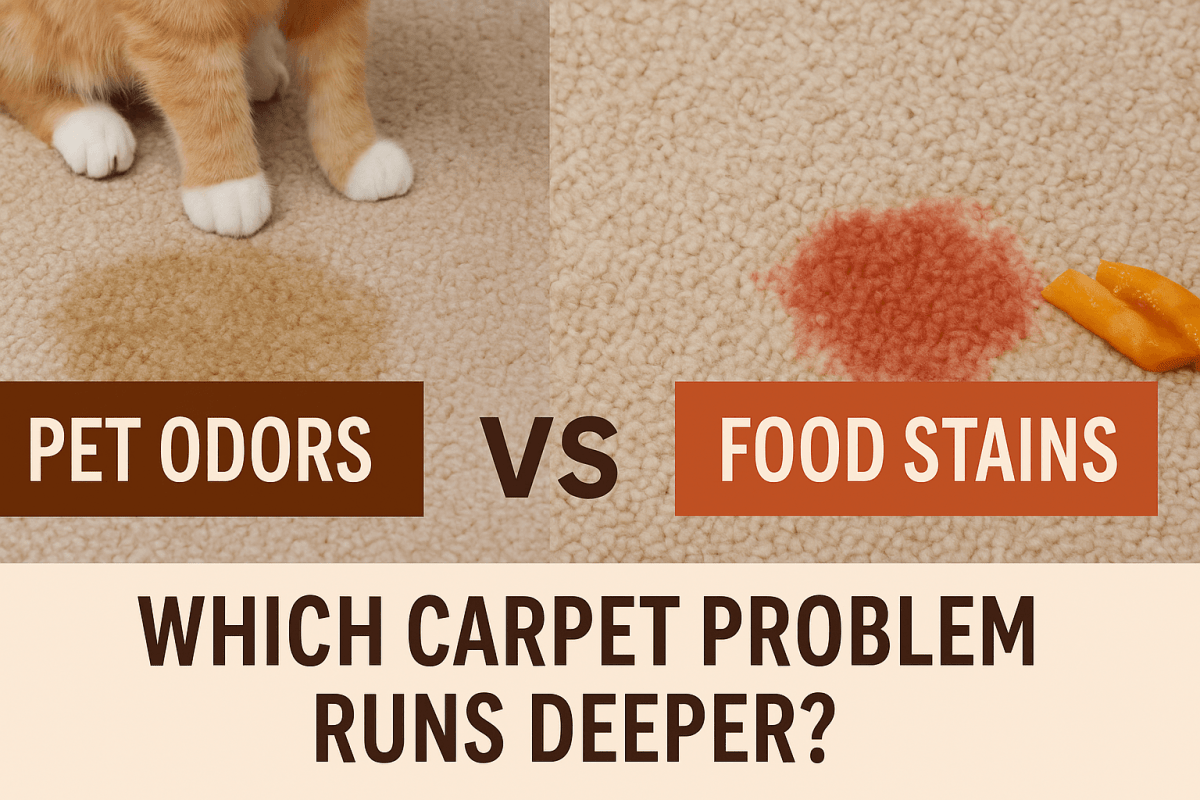A coffee spill may stain your carpet, but it won’t follow you around the room like a ghost. Pet odors, on the other hand, linger. They seep beneath the surface, cling to the fibers, and often outstay their welcome. If you’ve ever tried to mask the smell with candles or sprays, you already know — this isn’t just about what you see or smell. It’s about what’s hiding deep inside your carpet.
Whether you’re dealing with a beloved pup’s accident or last night’s pasta dinner on your oriental rug, not all stains are created equal. So, which is tougher to remove — pet odors or food stains? Let’s dig in.
Why Pet Odors Are Tougher Than They Smell
Pet urine is sneaky. It soaks in fast, often reaching the padding and even the subfloor before you’ve had a chance to blot. The real problem? Uric acid crystals. They bind to carpet fibers and don’t dissolve with water alone. Even worse, they reactivate when humidity rises, releasing that unmistakable smell all over again.
Unlike food stains that mostly sit on the surface, pet accidents become part of your carpet’s structure — especially if not treated right away. Regular household carpets might survive a few incidents. Oriental rugs? They’re another story. Acidic residues can alter dye patterns and damage delicate fibers.
Home Remedies That Actually Work (Sometimes)
For fresh accidents, a mix of white vinegar and water can help neutralize odors. Enzyme-based cleaners are your best bet — they’re designed to break down proteins in urine and remove the source of the smell. Baking soda can lift lingering moisture and help deodorize.
But here’s the catch: if the stain has dried or your pet’s made that spot their personal restroom, home solutions may only offer temporary relief. You’ll think it’s gone… until the next hot, humid day brings it back.
Why Food Stains Are Easier, but Still Tricky
Food spills can be dramatic — red wine, tomato sauce, curry — but they don’t usually soak in as deeply as pet urine. Most food stains live in the top layer of your carpet fibers. That’s good news. You have a better shot at removing them completely with prompt action.
Dish soap, warm water, or even a mix of vinegar and baking soda can often do the trick. But leave them too long, and some stains — especially those with tannins or grease — can set permanently. They may not smell, but they’ll definitely show.
Why Professional Cleaning Matters (Especially for Pet Odors)
At ZoltanCleaning, we’ve seen what happens when pet odors are left untreated — warped carpet backing, mildew beneath the surface, and rooms that never quite smell clean. Our deep cleaning process doesn’t just mask odors. We use professional-grade equipment and pet-safe enzymes to break down odor-causing compounds from the root.
Oriental carpets require a delicate touch. We assess the fiber type, dye stability, and construction before treating any pet stains. In many cases, we use a low-moisture method to lift the odor without compromising the integrity of the rug.
When to Call In Help
If your carpet still smells after cleaning… if your pet keeps returning to the same spot… or if you’re dealing with an antique rug that can’t be risked — it’s time to bring in the professionals. Pet odors aren’t just a nuisance. They’re a warning sign that bacteria, acids, and moisture are working their way deeper than you can see.
ZoltanCleaning provides tailored solutions for Orlando homeowners. From modern wall-to-wall carpets to hand-knotted Persian rugs, we know how to treat the surface — and what lies beneath it.

